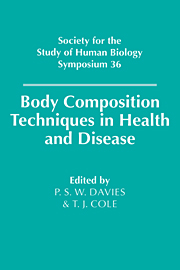Book contents
- Frontmatter
- Contents
- List of contributors
- 1 Application of dual-energy X-ray absorptiometry and related techniques to the assessment of bone and body composition
- 2 In vivo neutron activation analysis: past, present and future
- 3 Magnetic resonance imaging for the assessment of body composition
- 4 Multi-frequency impedance as a measure of body water compartments
- 5 Body composition assessed by electrical conductivity methods
- 6 Body composition in malnutrition
- 7 Influence of body composition on protein and energy requirements: some new insights
- 8 Prediction of adult body composition from infant and child measurements
- 9 Assessment of body composition in the obese
- 10 The role of body physique assessment in sports science
- 11 The assessment of the body composition of populations
- 12 Changes in approach to the measurement of body composition
- 13 Multi-compartment models for the assessment of body composition in health and disease
- 14 The future of body composition research
- Index
8 - Prediction of adult body composition from infant and child measurements
Published online by Cambridge University Press: 18 September 2009
- Frontmatter
- Contents
- List of contributors
- 1 Application of dual-energy X-ray absorptiometry and related techniques to the assessment of bone and body composition
- 2 In vivo neutron activation analysis: past, present and future
- 3 Magnetic resonance imaging for the assessment of body composition
- 4 Multi-frequency impedance as a measure of body water compartments
- 5 Body composition assessed by electrical conductivity methods
- 6 Body composition in malnutrition
- 7 Influence of body composition on protein and energy requirements: some new insights
- 8 Prediction of adult body composition from infant and child measurements
- 9 Assessment of body composition in the obese
- 10 The role of body physique assessment in sports science
- 11 The assessment of the body composition of populations
- 12 Changes in approach to the measurement of body composition
- 13 Multi-compartment models for the assessment of body composition in health and disease
- 14 The future of body composition research
- Index
Summary
Introduction
Anatomists demonstrated many years ago that organs grow at different rates, and that these rates can differ from the growth rate of the body as a whole (Forbes, 1978). Further, auxologists have shown that children grow at a variety of rates: they can play lento or allegro (Tanner, 1986). The first case corresponds to a normal process where growth is organised in successive steps, while in the second case individual variation due to genetic and/or environmental factors influences the growth process. This variation makes it difficult to predict adult body composition from childhood measurements. However, growth is affected by hormonal status, so that childhood is a good time to study the relationship between anthropometry and hormonal status, and to analyse the influence of environmental factors such as nutrition. In general, patterns of growth give more useful information than absolute levels of anthropometric measurements. Better understanding of factors influencing body composition can improve prediction of adult status and help to propose strategies for reducing the risk factors of various diseases.
Use of anthropometric measurements
Anthropometric measurements can be used in several ways: directly (e.g. skinfolds), as indices (e.g. weight/height2, the Quetelet or body mass index (BMI)), areas (e.g. upper arm muscle area (UMA) based on arm skinfolds and arm circumference) or in regression equations relating body density to anthropometric measurements for a reference population. In addition, various ratios can be used to predict body shape and proportion.
Direct measurements and the BMI predict the level of fatness, while UMA and the regression equations predict body composition (i.e. fat mass (FM), fat-free mass (FFM) and % body fat (%BF)).
- Type
- Chapter
- Information
- Body Composition Techniques in Health and Disease , pp. 100 - 145Publisher: Cambridge University PressPrint publication year: 1995
- 22
- Cited by



